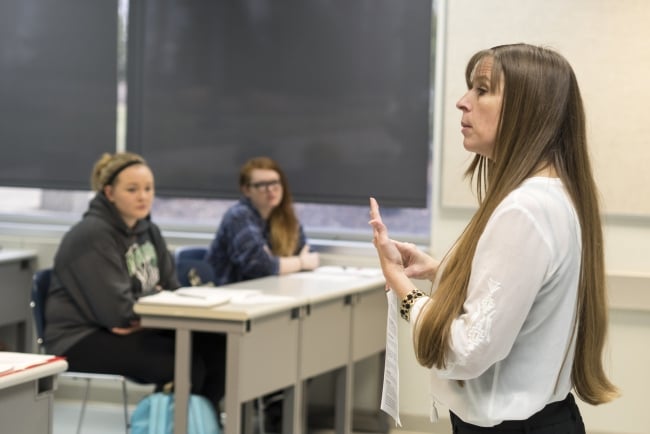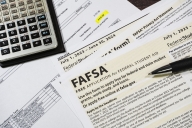You have /5 articles left.
Sign up for a free account or log in.

Accounting professor Patty Goedl created her own open-source textbook to make her course more affordable and increase the availability of free educational materials.
University of Cincinnati at Clermont
Rising costs of living and of higher education can be a barrier to students and their academic success. One professor decided to eliminate extra expenses in her classes by creating her own free textbook.
Patty Goedl, an accounting professor at the University of Cincinnati at Clermont, wrote an open-access textbook that connects learners with video lectures, written content, embedded quizzes and other resources to engage students of all learning styles at no cost to them.
Over the past three years, Goedl has developed and refined her textbook to be just as refined as publisher-created course materials, and she hopes other faculty members consider textbook affordability more when making choices for their classes.
What’s the need: Goedl has worked as an accounting professor at UC Clermont for 15 years. In 2014 she realized firsthand, as a parent, how expensive textbooks could be.
Buying print books for her two college-aged daughters could cost as much as $200 per class, and paying for five courses each term created a $2,000 bill in total. “It just blew my mind, because I could fully comprehend what students were paying,” she says.
In her own courses, Goedl found herself consistently negotiating with the publisher each semester to get a discount on digital textbooks, but she watched discounted rates slowly creep higher, making the deduction negligible. Students were also frequently reaching out to Goedl because they couldn’t afford the textbook at any price.
A 2022–23 survey of Goedl’s course participants found 58 percent of students disagree or strongly disagree that textbook prices are reasonable, and 56 percent disagree or strongly disagree textbooks are worth the price.
Nationally, a spring 2023 Student Voice survey from Inside Higher Ed and College Pulse found 50 percent of students have avoided purchasing or renting a book for class, and 55 percent of students say their preference for obtaining course materials is to find a free digital version.
“I thought, ‘I’m going to break free, and I’m going to write a book that is as high-quality as the book that I use from the publisher, and I’m going to write it as an OER,’” Goedl says.
OER’s Growing Trend
Research by the National Association of College Stores’ (NACS) OnCampus Research division has found that 37 percent of faculty members used open educational resources in 2022, on par with the year prior, but print materials remain the most popular, with 71 percent of all faculty using print materials.
West Texas A&M University recently announced the institution would no longer charge students for textbooks, with the university footing the bill for required materials and pushing faculty to engage with open educational resources.
Legislators are also pushing for more affordable course materials. California governor Gavin Newsom committed $115 million in 2022 to expand the state’s zero-textbook-cost programs to benefit community college students. In March, Congress introduced legislation to create a competitive national grant program for open educational resources.
In general, student course material spending is dropping, and the 2022–23 academic year marked a 50 percent decline in student spending over the past 10 years, according to OnCampus Research.
The textbook: To create her textbook, Goedl started with class materials she had already created, including videos, handouts and sample problems for quizzes and exams.
From there, she wrote content, created video lectures and established the textbook layout.
“I’m calling it a video etext, because I think the younger generation learns differently; they don’t learn from reading—especially a complex subject like accounting,” Goedl explains. “A student can read the whole book and not watch the videos and understand 100 percent of the content; the student can watch every video but not read a word and understand 100 percent of the concept.”
In the third edition of her book, she added additional materials, like a glossary, interactive material and supplemental concepts.
It wasn’t enough to just write course content for Goedl—she wanted her textbook to be on the same level as an established publishers’ material would be, with test banks, homework questions, learning management system elements and review assignments.
Over all, it’s been a years-long project with three editions as she continues to develop and refine content.
The biggest challenge was not compiling the information, but adding supplementary materials.
“I was a one-person team. I had to not only be the faculty member [but] the content creator, the expert, the IT person,” Goedl said. She hired a graphic designer to create images for the book but learned videography and video editing to shoot and cut her own clips.
Goedl’s text is hosted and supported by the UC Press department, something that makes a key difference, because there aren’t many faculty incentives to publish a book and many costs associated with the process. “Writing the book was a third of [the labor]; the other two-thirds was everything else,” she says.
The impact: Goedl launched the textbook in fall 2021, and the student response has been “amazing,” she says. The textbook is available to anyone with a link, so a learner doesn’t have to be enrolled in her course or at UC Clermont to take advantage of the resource.
Each semester Goedl has collected survey data from students, and she has learned students prefer her textbook to a traditional publisher’s and find it equivalent in quality to a publisher’s book.
Goedl’s spring 2023 survey found 89 percent of students prefer her etext and video format to a traditional textbook, and 85 percent believe the etext and videos are an equivalent resource to a standard publisher textbook.
In the future, Goedl plans to continually improve the book, adding additional elements teaching Excel and Excel-based assignments.
“I hope that this textbook does inspire faculty to at least examine textbook costs and realize that, even if they don’t want to write it themselves, that there is content available,” Goedl says.
Seeking stories from campus leaders, faculty members and staff for our Student Success focus. Share here.




